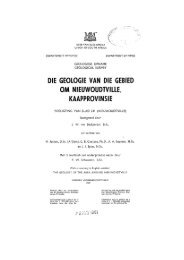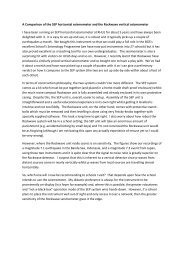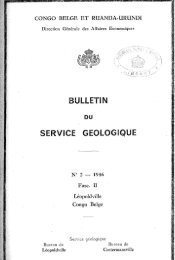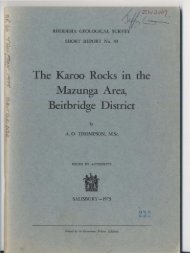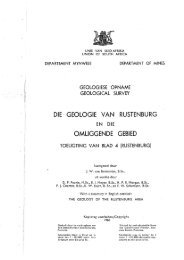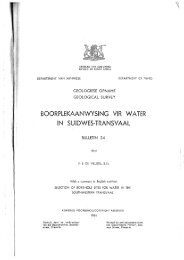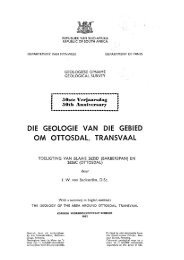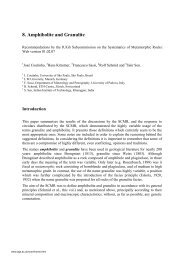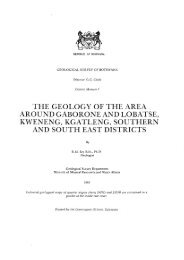Bibliography - British Geological Survey
Bibliography - British Geological Survey
Bibliography - British Geological Survey
Create successful ePaper yourself
Turn your PDF publications into a flip-book with our unique Google optimized e-Paper software.
‘Piltdown Man’ inn was analysed by Dr Roy C. Hoather, and samples of gravel and loam from the Piltdown<br />
site by Dr C. Bloomfield, both of which yielded notably low values of sulphate.)<br />
Claringbull, G. F. & Hey, M. H. 1955. The X-ray crystallography of the Piltdown fossils. In: Further<br />
contributions to the solution of the Piltdown problem / J. Weiner et al. Bulletin of the <strong>British</strong> Museum<br />
(Natural History), Geology, 2 (6), 268–270, plate 31. (Formal report of the presentation made in 1954)<br />
Claringbull, G. F. (see also under Anon. 1954c)<br />
Clark, W. E. Le Gros (see under Le Gros Clark, W. E.)<br />
Clarke, E. V. 1954. [Summary transcript of interview with J. S. Weiner concerning the character of Charles<br />
Dawson.] See Spencer 1990b, 239, etc.<br />
Clemens, W. A. 1963. Wealden mammalian fossils. Palaeontology, 6 (1), 55–69. (Includes a reassessment<br />
of Plagiaulax dawsoni Woodward 1892, which is here described as being of doubtful affinity. All that now<br />
remains is a fragment of the root of the molar tooth, the crown having been lost since it was last described by<br />
Simpson in 1928. The root, as now revealed, contains only a single pulp cavity, which ‘strongly suggests<br />
that it is not the tooth of a mammal’, pp. 55–56. Of the two so-called Plagiaulax-like teeth described by<br />
Woodward in 1911, one tooth, M10481, is referable to Loxaulax valdensis, which was found by Teilhard de<br />
Chardin; the other, M20241, has a crown which is so badly decayed that it cannot definitely be assigned as<br />
mammalian, pp. 57–58.)<br />
Clements, J. 1982. Piltdown revisited. Popular Archaeology, 3 (May), 30–31. (See response by Joel 1982)<br />
Clements, J. 1997. Piltdown man again. Current Archaeology, 13 (7), no. 151, 277. (Description of the<br />
events at Hastings, beginning in 1858, which could have provided Dawson with his ‘Piltdown’ material)<br />
Clements, J. 1997. Reviewing Piltdown: the Hastings connection. Hastings Area Archaeological Research<br />
Group Journal, new ser. no. 4 (Dec), 8‒10.<br />
Clermont, N. 1992. On the Piltdown joker and accomplice: a French connection? Current Anthropology,<br />
33 (5), 587. (A comment on Tobias’s defence of Teilhard de Chardin (ibid., 33, 244), in which the writer<br />
quotes a letter from Teilhard which he interprets as providing evidence of Teilhard’s knowledge of the<br />
existence of the Piltdown canine 13 months before he was to find it! Clermont’s reading of this letter has<br />
been dismissed by Walsh (1996, 147–8). There was also some correspondence from Francis Thackeray<br />
under this heading.)<br />
Clinch, G. 1905. Early man. In: The Victoria history of the county of Sussex. Volume I, edited by W. Page,<br />
309‒332. (Description and illustration of a piece of fossil red deer antler pierced by a square hole, which<br />
Charles Dawson claimed was an ancient hammer found at Bulverhythe, pp. 327‒328 & plate facing p. 318.<br />
The modern view, as expressed by Russell 2003, 86‒89, is that the hole has been cut with a steel knife in a<br />
way comparable to the Piltdown ‘cricket bat’. Clinch also lists and illustrates (pp. 327, 330 and facing plate)<br />
some objects from a Bronze Age hoard that was found at St Leonards on Sea and became part of the Dawson<br />
Loan Collection at Hastings Museum, over which hang the usual question marks, Russell 2003, 89‒93. A<br />
description of the Lavant Caves (pp. 326–327) represents the only published account of the findings of the<br />
exploration undertaken in 1893 by Dawson and Lewis, apart from a report that appeared in the Sussex Daily<br />
News, 11 Aug 1893; also included (plate facing p. 326) is a plan drawn by Lewis; see also McCann 1981.)<br />
Cockburn, A. 1970. A skull for scandal. Sunday Times Magazine, 8 Mar, 30–34. (It was this account that<br />
got the compiler of the present Select <strong>Bibliography</strong> hooked on the subject of Piltdown, and led in 1971 to his<br />
first attempt at identifying published references, aided by his appointment in June of that year to a position in<br />
the library at the <strong>Geological</strong> <strong>Survey</strong>, South Kensington, now at Keyworth, Nottingham.)<br />
Cockburn, C. 1954. Truth is stranger than Piltdown. Punch, no. 227 (1 Dec), 687–689.<br />
Cole, S. M. 1955. Counterfeit. London: John Murray, 209 pp. (The Piltdown puzzle, pp. 136–167. Also<br />
discusses the infamous Glozel finds, mentioned by Teilhard in a letter to Oakley (Spencer 1990b, 212), and<br />
the Calaveras skull. For an excellent account of the Glozel forgery, exposed in France in the late 1920s, see<br />
A. Vayson de Pradenne, The Glozel forgeries, Antiquity, 4, no. 14, June 1930, 201–222, translated from the<br />
French by O. G. S. Crawford.)



